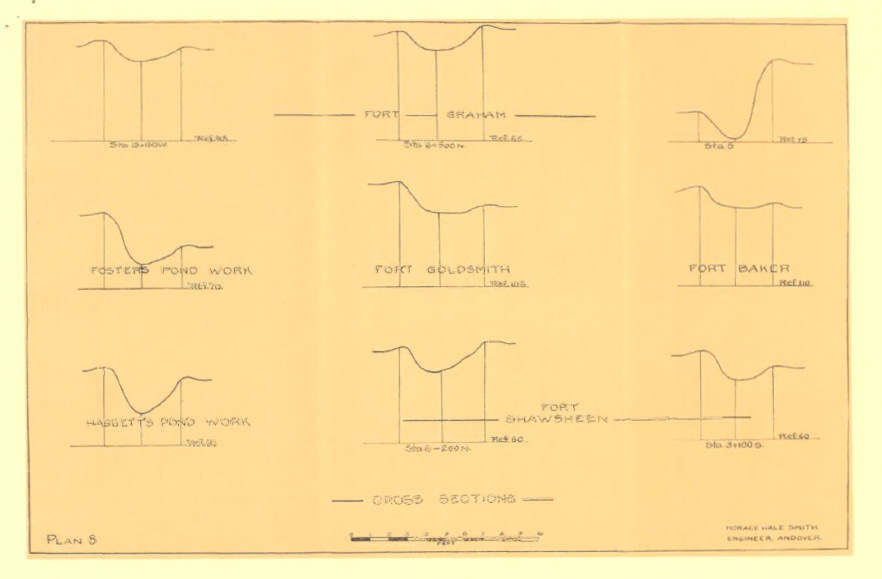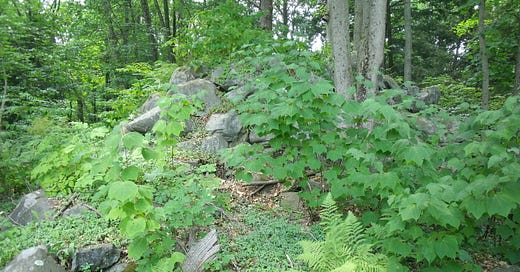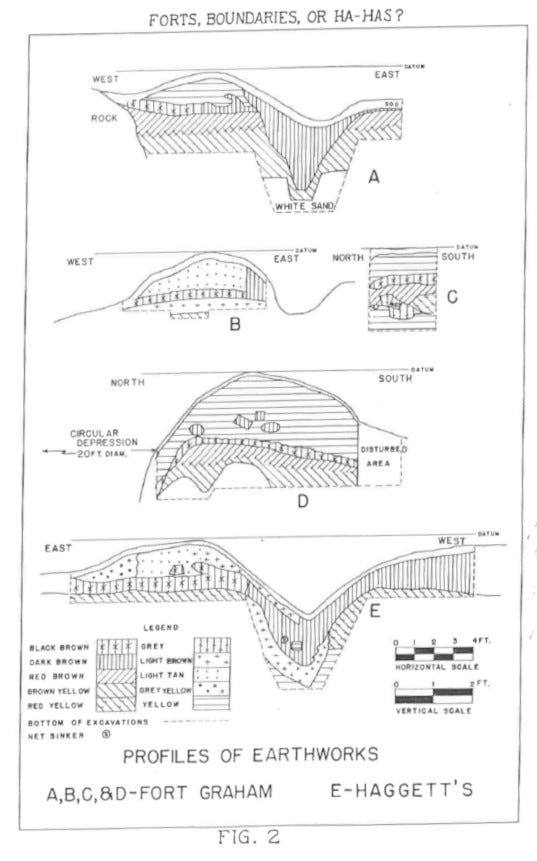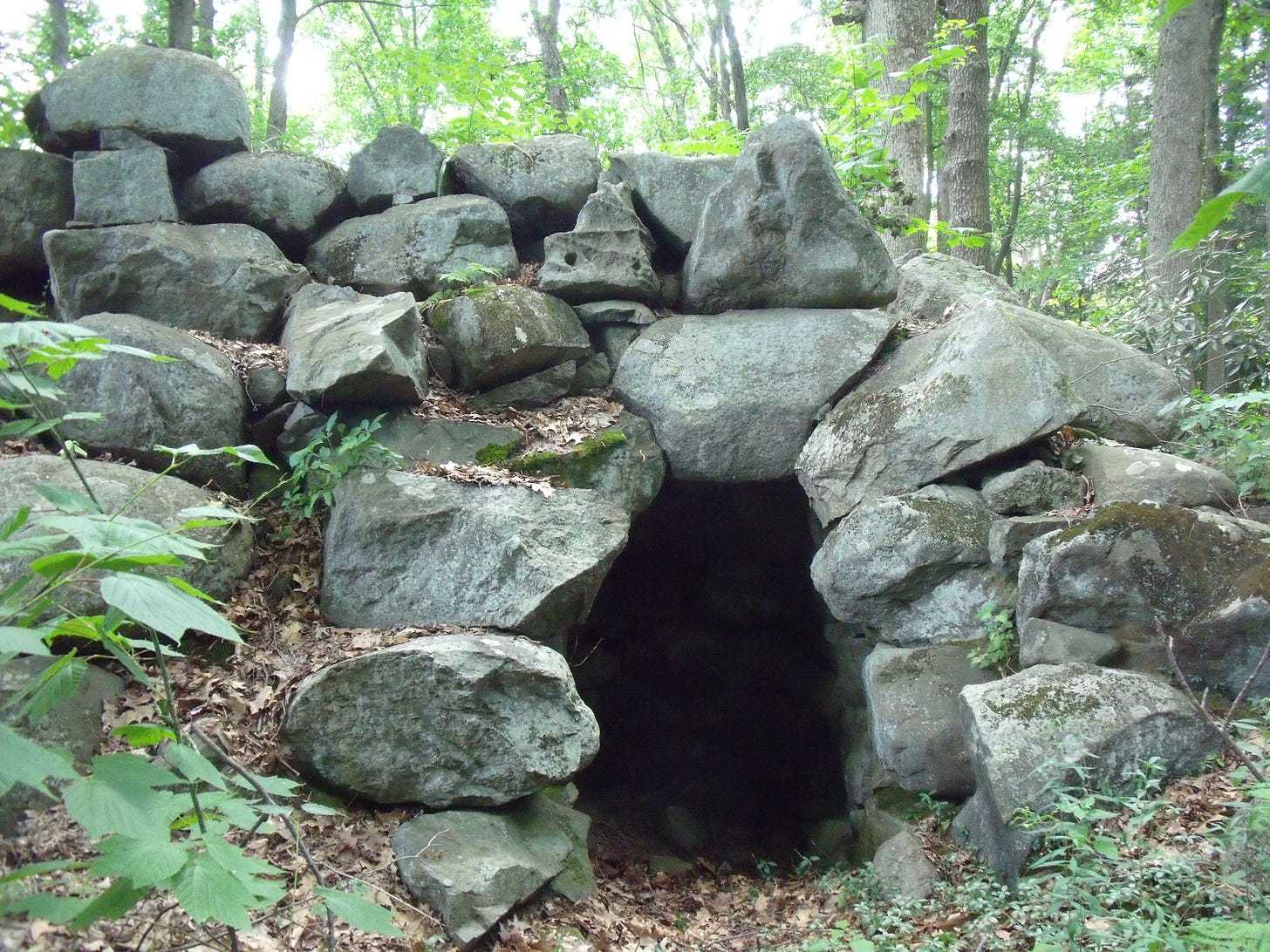Miscellany Monday or Mystery Monday: Turtle Mound, part 1
“Certain Peculiar Earthworks Near Andover, Massachusetts”
Thank you to History Buzz writer Floyd Greenwood for his many Miscellany Monday articles! Floyd started writing Miscellany Monday for History Buzz back in January 2021. Now that he’s headed back to school, Floyd’s August 16th article on Pomp’s Pond will be his last….not for always, I hope….but for a while at least. In honor of Floyd’s stories about Andover’s green spaces, today is the first of two stories about Andover’s Turtle Mound reservation.
~Elaine
Starting at the beginning: What is Turtle Mound?
Turtle Mound is a wooded site in Andover with a stonework feature that, when seen from above, is said to resemble a turtle. In 2015, the site was acquired by the Andover Village Improvement Society (AVIS). The .8 acre site is located off Lakeside Circle in West Andover, near Haggetts Pond.
100 years of theories about the site and its layers of history still have not proven its origin or purpose.
The mystery, part 1
There are two layers to the Turtle Mound mystery: above-ground stonework and ground-level earthworks. Early interest by archaeologists was with the ground-level earthworks.

Earthworks - 1912
In 1912, Warren K. Morehead curator of the Phillips Academy Department of Archaeology, published the report, “Certain Peculiar Earthworks Near Andover, Massachusetts.” In his report, Morehead laid out his theory that the earthworks were fortification, or “forts,” built by Native American people. He based his theory, in part, on the absence of European materials (glass beads, etc.) at the site. He concluded that the site was pre-colonial and that the residents who constructed the earthworks had not been in contact with settlers.

Supporting his theory, Morehead also noted that a later resident in the area, Mr. Follansbee, had collected many chips, flakes, spalls, and other evidence Native American stonework.
Morehead worked on his research with Mr. C.C. Willoughby from the Peabody Museum at Harvard University and engineer Horace Hale Smith. The trio compared the Haggetts Pond “embankments and ditches” found at the site to other Native American “forts” in Massachusetts, and in Andover. Other forts in Andover, he wrote, included Fort Graham, Fort Goldsmith, Fort Shawsheen, Fort Baker, and Fort Benner.
The Haggetts Pond earthworks, they concluded, were similar to these other forts.

Morehead discounted other theories about the site that proposed that the earthworks were constructed by colonists to define boundaries, serve as fire breaks or drainage ditches, or that they were Colonial fortifications during the French and Indian Wars.
The earthworks were, Morehead concluded, likely fortifications of Native American origin.
Earthworks – 1942
In 1942, archaeologist Ripley Bullen published the article “Forts, Boundaries, or Ha-Ha’s” in the Massachusetts Archaeologist Society’s Bulletin.
Referring perhaps to Morehead’s 1912 report, in the first paragraph of his article Bullen described site as the “so-called Indian forts, or earthworks.”
Bullen wrote that he would be the first to use “modern archaeological investigation” methods that earlier writers did not have access to. To illustrate his point, he referred to a 1906 study that posited that fortifications of the site included a wooden stockade. By using modern archaeological techniques, he found no evidence of post holes to support that theory.
Bullen examined the soil within the embankments and ditches.
“Due to the absence of other evidence of Indian occupation the author feels that this ditch is post-Indian and consequently dug by white settlers. The clods seem to bear this out, indicating presumedly, metal shovels. It also seems to be too far away from the Indian site to be considered the possible remains of a stockade, not to mention the fact that no post holes were found.”
To support his conclusions, Bullen also noted that there was very little evidence of Native American occupation on the site. He thought that exploring the earthworks as a post-Native American colonial feature was a better direction.
Bullen considered other theories about the earthworks. Were they colonial flax rotting pits, fortifications during French and Indian Wars, fire breaks, drainage ditches, boundary lines, or “ha-has” to contain animals?
Taking these into consideration, Bullen concluded that there was likely no one single reason for the ditches. He did, however, eliminate the theories about flax rotting pits and French and Indian War fortifications due to the size and location of the ditches.
Bullen also looked into Andover Town appropriation records and found no evidence of fire breaks having been constructed. His article included this amusing line,
“For many years – at least from 1722 to 1788 – they mention appropriations for cleaning the fish courses so that it is not likely that one for cleaning fire breaks would have been omitted.”
Bullen then eliminated the drainage ditch theory, noting that the trenches ran up and down hills, so wouldn’t have been effective for drainage.
He moved on to the ha-ha fence theory.
“Ha-has are sunken fences used principally in England to restrict the range of cattle and sheep or to keep out deer…Apparently a classic ha-ha should have a fence along the mound. However, it can still be a ha-ha without the fence, one steep wall serving as the fence. No indication of fence post holes was found…”
Bullen compared the Haggetts Pond earthworks to similar features in Hadley, Massachusetts as described in The History of Hadley.
“The broad ditch and high bank of earth thrown out of the ditch were an important part of the old common fence…for the object of the fence was to secure the meadows from domestic animals that roved in the woods outside the bank…The people of Hadley fenced common fields, school meadow and home-lots…”
Bullen wrote, “it is interesting to note that, ‘The ditch fence was used many years after 1800” and “A writer of 1848 says, ‘There is now a fence where the sheep pasture fence was, and the ditch of the old common fence still stretches up the mountain side. Most of the old sheep land is now in woodland.”
He continued,
“The above indicates that these ha-has were common in the Connecticut Valley in Colonial days. The similarity to many of the Andover earthworks in the location and description suggests a common purpose. It is logical to expect that as the meadow land was divided up, part, at least, of these ha-has would become boundary lines, as indicated in the preceding paragraph.”
Bullen concluded that the Haggetts Pond earthworks (along with Andover “Forts” Graham, Shawsheen, and Benner) were sunken fences known as “ha-ha’s” used to contain livestock, as shown in the illustration below. The ditches likely became boundaries as land was divided.
The earthwork mystery remains
Between the two reports, we have many theories but still no definitive conclusions. Were the earthworks - a series of ditches and embankments that run throughout the site - created by Native Americans as forts before the arrival of colonists? Or were they created by the colonists as sunken fences to contain livestock and serve as boundaries? Or is there another answer? We may never know for certain.
As the land around the ditches and embankments became more wooded, the earthwork features became obscured. Theories about the site moved on to the above ground stonework.
Part 2, the mystery of the Turtle Mound stonework
Aside from these two articles by professional archaeologists about the earthworks, most of the interest – and all of the fascinating, outrageous theories and research – has been written about the above ground stonework on the site.
Vikings? Irish monks? Ancient burial ground?
Stay tuned for the next Miscellany Monday/Mystery Monday story in a few weeks for the story of the Turtle Mound stoneworks.
Thanks for reading!
~Elaine









The stone works seem a lot like the structures described by the Nolumbeka Project - they've had some fascinating on-line presentations about such sites and the need to preserve them.
See: https://nolumbekaproject.org/sacred-site-preservation/
What a great article!!!!!